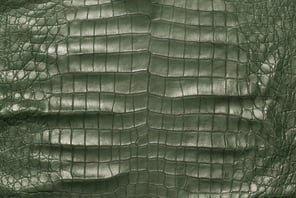
When you’re shopping for exotic leather, two of the most important things to keep in mind (regardless of the type of skin you’re ordering) are the size of the skin and its grade. If a skin is the wrong size or grade, it could have a significant impact on your acquisition costs and your ability to actually use the skin for your project.
Generally speaking, the larger the panels you need for your project, the larger and higher-grade the skin needs to be.
What Does “Grade” Mean for Exotic Leathers?
For exotic leathers, the “grade” is a general measurement of the skin’s overall quality. The better the grade, the fewer defects there are in the hide. For example, a “Grade 1” skin is virtually free of any defects in the hide—making these skins the most valuable (and thus, expensive) option available.
Some skins may have more grades than others, but the typical limit is Grade 4, which indicates a skin with a lot of flaws or defects. Grade 4 skins tend to be the least expensive option per centimeter of hide but aren’t suitable for projects that require large patches of unblemished hide.
One factor that can affect the availability of Grade 1 skins is where the leather is typically sourced from. Exotic leathers that are usually collected from farms tend to have higher-grade skins available more often. Meanwhile, skins that come from wild-caught sources more frequently have significant blemishes that lower their grade.
This is because farmed animals are protected from conflict and predation that would result in punctures, scars, and scratches that could damage their hide. Wild animals, on the other hand, are at the mercy of nature—not just potential extreme weather but also fights with other animals that could result in damage.
Grading Different Types of Exotic Leather
While most types of exotic leathers follow the same general rules for their grading (i.e., fewer blemishes means a higher grade), they may have some unique ways of reaching a specific grade result based on the shape of the skin and how it’s measured.
Here are some quick explanations of skin grading for different types of exotic leather:
Shark Skin Grades
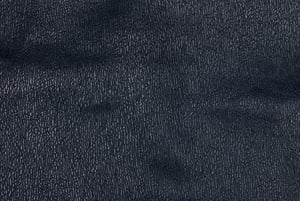 Shark skin, like many other exotic leathers, is separated into four distinct grades based on how pristine the skin is. Grading is done on two different sections of the shark skin—the section above the largest fin hole in the center of the skin and the section below said hole.
Shark skin, like many other exotic leathers, is separated into four distinct grades based on how pristine the skin is. Grading is done on two different sections of the shark skin—the section above the largest fin hole in the center of the skin and the section below said hole.
The more scratches, scuffs, and scars the skin has, the lower its grade. Here are the four grades of shark skin:
- Grade 1 shark skin. These skins are free of any significant defects in the center of the two main sections. Grade 1 is very rare because shark skin is collected from wild sources instead of farms.
- Grade 2 shark skin. A grade 2 shark hide will have a small defect or cluster of defects in one half of one section of the skin. These defects can usually be worked around with ease.
- Grade 3 shark skin. These shark leathers will have a small defect or defect cluster appearing on two halves of either main section of the shark skin.
- Grade 4 shark skin. The shark hide has multiple defects in both sections of the hide—worse than grade 3 shark skin.
The majority of defects take the form of scars, scrapes, scratches, and holes.
Because these hides are taken from wild sharks that are hunted for their meat, grade 1 and 2 shark skin is comparatively rare. Grade 3 and 4 shark skin are much more common.
American Crocodile Skin Grades
The grade assessment for American crocodile leather is made based on the condition of the belly. There are four grades of American crocodile skin (ranked from best to worst):
- Grade 1. These are the “pristine” or “flawless” skins that have no defects in the belly.
- Grade 2. These skins might have a solitary defect or a small cluster of defects on the outer edge of the belly—these are usually easy to work around.
- Grade 3. There may be a defect or a small cluster of defects in or near the center of the belly, which may be somewhat difficult to work around (depending on the application).
- Grade 4. Here, there are defects present in more than a single quadrant of the belly.
Naturally, the worse the grade and the smaller the size, the less expensive the American crocodile skin will be. When shopping for exotic leather, it’s important to consider your application and how easy it will be to work around any defects in the hide.
American Alligator Skin Grades
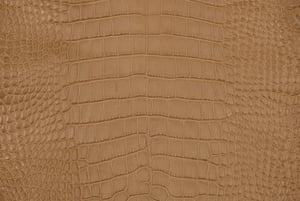 American alligator skin is graded on the midsection only, including the belly and flank. The condition of the head and tail are not typically considered in the grading.
American alligator skin is graded on the midsection only, including the belly and flank. The condition of the head and tail are not typically considered in the grading.
The grades for this exotic leather are defined as follows:
- Grade 1: No defects in the belly.
- Grade 2: One cluster of defects on the outer edge of belly or flank.
- Grade 3: One cluster of defects in the center belly.
- Grade 4: Clusters of defects in two different quadrants of the midsection.
- Grade 5: Worse than grade 4.
Defects are most often scars, scratches, shading or scaling deformities. In some rare cases, defects may include holes and grain issues. Anything with holes or grain issues would be downgraded to a grade 4 at best. Skins that are grade 3 or better will not have holes or grain issues in the midsection.
You may notice that this skin, unlike the previous two entries, has five grade ranks instead of four. This helps to more finely establish the quality of the skin just by identifying the grade since it’s one of the most expensive types of exotic leather to acquire.
Python Skin Grades
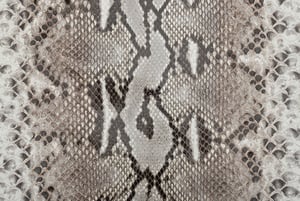 Python skin is graded on the center ⅔ of the skin. So short-tailed python skins are graded on the center meter and diamond python skins are graded on the center two meters.
Python skin is graded on the center ⅔ of the skin. So short-tailed python skins are graded on the center meter and diamond python skins are graded on the center two meters.
There may be small holes on the very outer edges of all skins where the toggling clips are clipped during the tanning process, but this does not affect the cutting area, so it is not factored into the grading. Grades are defined as follows:
- Grade 1: No defects in the center. Ideal for handbags, garments, interiors, large footwear panels, belts and other large accessories.
- Grade 2: Small and clustered defects in the center. Ideal for small footwear panels, electronics accessories, wallets and small leather goods.
- Grade 3: Has either many small defects in the center or several large defects in the center. This grade of hide is best for small leather goods, jewelry or practicing crafting with python skin.
For python skins, defects typically include pinholes, scratches, scars and scaling deformations.
Measuring Different Exotic Leathers
When purchasing exotic leather of any kind, it’s important to know what size of leather you’re working with. However, not all types of skin are measured the same way. Different hides have different shapes, which impacts how the leather they produce is measured and what size and shape panels they’re best for.
Here’s a quick breakdown of how different hides are measured:
Measuring Shark Skin
Typically, a shark skin is measured in square feet by a machine. They range from 3 to 7 square feet, with a 4 square foot average total. Of course, these skins aren’t perfect squares. They are an imperfect diamond shape with a hole in the center and towards the back where the fins were.
Like many other exotic leather products, shark skin tapers from one end to the other. When measuring shark skin, they tend to be around 30 inches long and 20 inches wide at their widest point.
Measuring American Crocodile Skin
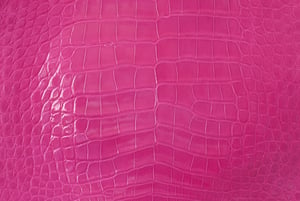 American crocodiles are one of the larger crocodilian species (though not the biggest), with adults hitting an average length ranging between 3.8 and 4.5 meters. However, when measuring an American crocodile skin, it’s not the length of the hide that’s typically measured, but the width of the belly at its widest point.
American crocodiles are one of the larger crocodilian species (though not the biggest), with adults hitting an average length ranging between 3.8 and 4.5 meters. However, when measuring an American crocodile skin, it’s not the length of the hide that’s typically measured, but the width of the belly at its widest point.
When measured by belly width, American crocodile skins can vary from 35 cm wide to 75 cm wide—but, the majority of available skins will be around the 50-69 cm range. Depending on the overall size of the American crocodile in question, the hide may have between 25 and 34 rows of belly scales, with 14-16 scales per row.
As a rule, wider American crocodile skins also tend to be longer relative to other crocodile species, meaning they’ll have more belly scale rows for you to work with.
Measuring American Alligator Skin
Like American crocodile skins, alligator skins are measured primarily by the widest point of the belly (not including any hard bones in the hide). Wild skins are available in 30-100 cm, with an average of 50 cm. Farm skins run mostly 20-44 cm, average 30 cm.
Here’s a table showcasing some average measurements based on common alligator belly size ranges:
|
Size Range |
20/24 cm |
25/29 cm |
30/34 cm |
35/39 cm |
40/44 cm |
45/49 cm |
50/54 cm |
55/59 cm |
60-64 cm |
|
Head Width |
15 |
20 |
25 |
25 |
27 |
32 |
29 |
29 |
31 |
|
Head Length |
15 |
20 |
30 |
25 |
30 |
35 |
34 |
34 |
39 |
|
Belly Width |
22 |
27 |
32 |
37 |
42 |
47 |
52 |
57 |
62 |
|
Belly Length |
19 |
30 |
35 |
35 |
36 |
36 |
39 |
42 |
45 |
|
Top of Tail Width |
17 |
20 |
24 |
27 |
29 |
33 |
37 |
41 |
44 |
|
Tail Length |
43 |
50 |
65 |
70 |
85 |
90 |
94 |
98 |
108 |
|
Total Length |
88 |
100 |
150 |
155 |
168 |
178 |
180 |
182 |
197 |
|
Average Thickness (mm) |
0.8 |
0.8 |
1 |
1.3 |
1.3 |
1.4 |
1.5 |
1.6 |
1.8 |
Note that this table denotes averages for certain ranges of alligator belly widths. Actual sizes on specific hides may vary from these values.
Measuring Python Skin
Python skin is measured in terms of both length and width at the center. Length is typically measured in meters and width is typically measured in centimeters at the widest point of the skin.
The reticulated python skin carried by PanAm Leathers averages 3.25 meters in length, 31-32 cm in width at the widest point and 15-16 cm in width at the ends.
Meanwhile, the short-tailed python carried by PanAm Leathers averages 1.5 meters in length, is 28-29 cm in width at the widest point, and is 14-15 cm in width at the ends. Both python skins average 0.8-1.0 mm thickness in the center.
The tapering of a python skin will affect how much the skin will yield for panels in your exotic leather designs. This is why it’s important to know the width at both the widest point of the hide and at the ends.
Picking a Size and Grade of Exotic Skin for Your Project
Exotic leather of any kind can be expensive, so you want to make sure you get the most out of your skin. The ideal size and grade of skin needed for your project depends on the size of your panels, how much seaming you are comfortable with both technically and aesthetically, and also the scale (or other natural skin pattern) size with which you are comfortable.
For example, you probably don’t want huge scales on a small card case. Meanwhile, handbags typically require the best grades, followed by garments and upholstery, then footwear, and finally belts and smaller leather goods.
Need help finding the perfect alligator skin or crocodile skin for your needs? Contact the exotic leather experts at Pan American Leathers today!



